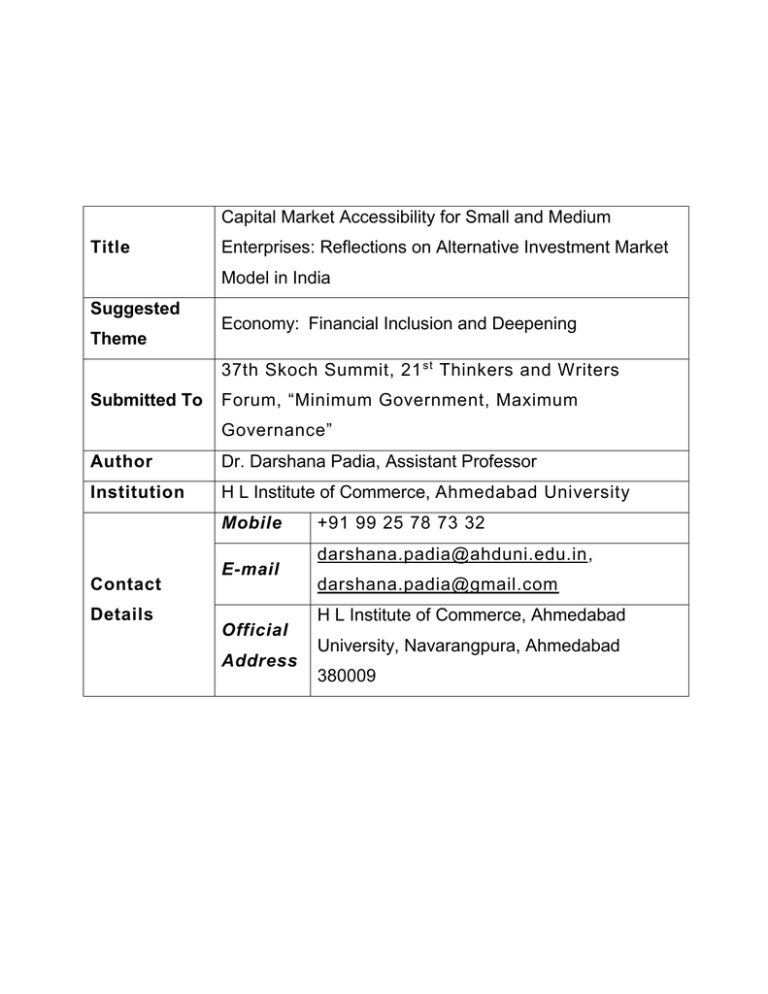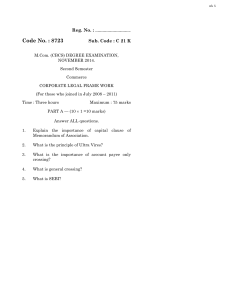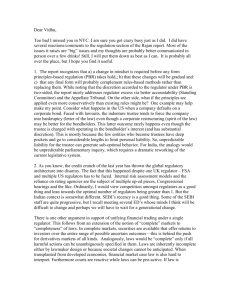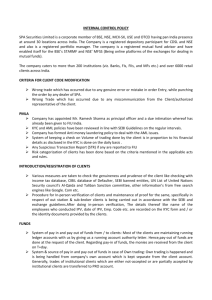Capital Market Accessibility for Small and Medium Enterprises
advertisement

Capital Market Accessibility for Small and Medium Title Enterprises: Reflections on Alternative Investment Market Model in India Suggested Theme Economy: Financial Inclusion and Deepening 37th Skoch Summit, 21 st Thinkers and Writers Submitted To Forum, “Minimum Government, Maximum Governance” Author Dr. Darshana Padia, Assistant Professor Institution H L Institute of Commerce, Ahmedabad University Mobile Contact Details E-mail Official Address +91 99 25 78 73 32 darshana.padia@ahduni.edu.in, darshana.padia@gmail.com H L Institute of Commerce, Ahmedabad University, Navarangpura, Ahmedabad 380009 ABSTRACT This paper discusses how the existing primary capital markets are designed to adhere to the need of big firms and how they create impediments for small firms. SEBI has created various substructures within the primary capital market for the small and medium sized firms to avail these markets. There are Small and Medium Enterprise (SME) Platform, Over-The-Counter Exchange of India (OTCEI) and Alternative Investment Funds (AIF). All these are regulated and streamlined under the primary capital market and have gradually developed over a period of time to make capital markets more inclusive. However, there exists complexities in time, structuring and listing of securities resulting in less or non-accessibility of potential funds for small or medium enterprises. The paper attempts to compare and contrast these various substructures created by SEBI and the major impediments thereof. The paper also briefly looks up the functioning of Alternative Investment Market (AIM) of London and attempts to list a few important lessons from the same. 1 Capital Market Accessibility for Small and Medium Enterprises: Reflections on Alternative Investment Market Model in India Introduction Capital markets are an essential mechanism to create a favorable financial climate that boosts economic development. There are two important dimensions that have to be carefully scrutinized to keep the growth momentum going: 1) The way capital markets are formed, regulated and monitored and 2) The ways to access these capital markets The role of capital market lies in mobilization of savings, regulating of funds, capital formation, providing investment alternatives, speed up economic growth and development, deliver financial services and ensure continuous flow of funds between Savings, Consumption and Investment in any economy. In India, Securities and Exchange Board of India (SEBI) is the regulatory authority for capital markets and it is quasi-legislative, quasi-executive and quasi-judicial. It means it enacts legislations, conducts investigations and enforces actions. There are regulatory norms through which companies get listed in the securities market and can avail the benefit of raising the finance fairly and easily. Listing broadly means admission of ‘Securities’ of a company on a recognized stock exchange. The purpose of listing is different for different parties. A company lists its securities to avail liquidity from the market, an investor is interested in listed securities as it ensures transparency through full disclosures and the government will aim to regulate securities market by listing so as to mobilize savings for economic development. (BSE, 2014). Currently in India the main capital markets exist in terms of stock exchanges where securities of specific types and sizes are traded. SEBI does this through creation of companies, charters or vehicles. To avail the benefit of capital markets there are minimum listing requirements in terms of paid-up capital, market capitalization, track record, and issue sizes. Rationale This paper discusses how the existing primary capital markets are designed to adhere to the need of big firms and how they create impediments for small firms. SEBI has created various substructures within the primary capital market for the small and 2 medium sized firms to avail these markets. There are Small and Medium Enterprise (SME) Platform, Over-The-Counter Exchange of India (OTCEI) and Alternative Investment Funds (AIF). All these are regulated and streamlined under the primary capital market and have gradually developed over a period of time to make capital markets more inclusive. However, there exists complexities in time, structuring and listing of securities resulting in less or non-accessibility of potential funds for small or medium enterprises. The paper attempts to compare and contrast these various substructures created by SEBI and the major impediments thereof. The paper also briefly looks up the functioning of Alternative Investment Market (AIM) of London and attempts to list a few important lessons from the same. Capital market and its importance The under given figure 1 displays the number of Demat accounts in the country reflecting the number of prevailing investors. It also shows the number of listed companies that were able to avail the benefit of the capital markets and reflects the amount of the total financial resources mobilized in the economy. Fig. 1 Demat Accounts (in lakh) Year NSDL CDSL 2011-12 120.5 79.0 2012-13 126.9 83.3 2013-14 130.6 87.8 No. of Listed Companies Year NSE BSE MCX-SX 20111,646 5,133 NA 12 20121,666 5,211 0 13 20131,688 5,336 12 14 Resource Mobilization through Public and Right Issues Particulars 2012-13 No. of Amount Issues (Rs. Crore) Public Issue 53 23,510 Right Issue 16 8,945 Total Equity and Bond 69 32,455 Total 6,779 6,878 7,036 2013-14 No. of Amount Issues (Rs. Crore) 75 51,075 15 4,756 90 55,652 Source: http://www.sebi.gov.in/cms/sebi_data/attachdocs/1408513411215.pdf The figure shows that there has been a steady increase in the number of Demat accounts and the number of listed companies. However, the number of increase in listing has only risen by 2 percent as compared to the growth of investors by 4 percent. 3 It shows that in 2013-14, 90 companies accessed the primary market and raised Rs. 55,652 crore through public and rights issues as against 69 companies which raised Rs. 32,455 crore in 2012-13. There has been a significant increase of 30 percent in fund mobilization in just one year. The noteworthy point is that though the number of Initial Public Offer (IPO) in 2013-14 rose to 38 from 33 in the year 2012-13, the amount raised drastically slumped to Rs. 1,236 crores in 2013-14 as against Rs. 6,528 in 2012-13. Another important highlight is that, out of the 38 IPOs, 37 were listed at the SME platform of SEBI. (SEBI Annual Report 2013-14). This indicates that number of SMEs are trying to tap the mainstream capital market but are unable to realize its full potential. This is a significant indicator as it demonstrates that SEBIs SME platform is not able to provide sustainable funding options to deserving SMEs. The SME Platform In 2013-14, 37 issues were listed at the SME platform raising a total amount of Rs. 317 crore as compared to Rs. 239 crore raised through 24 issues in the 2012-13, indicating an increase in resource mobilization to the tune of 32.6 percent. The major advantage of SME platform is that start-ups and SMEs can get listed without making an IPO. (SEBI Annual Report 2013-14). The importance of SME platform and its limitations can be fully understood in light of the projection of number of SMEs and the value of its assets in MSME Report, 2013-14. Figure 2 shows projected performance of SSI/MSME in terms of growth in number of SMEs and the investment needed. Fig. 2 Projected Performance of SSI/MSME 480 1,300,000.00 1,250,000.00 1,200,000.00 1,150,000.00 1,100,000.00 1,050,000.00 1,000,000.00 460 440 420 400 2010-11 2011-12 Total Working Enterprises (in Lakh) 2012-13 Market Value of Fixed Assets (Rs. in Crore) Source: Annual Report 2013-14, MSME, GOI, New Delhi It can be seen that the need of funding is growing. As per the Central Statistical Office (CSO), India’s Gross Domestic Savings as a percentage of GDP at market prices has 4 gone down to 30 percent in 2012-13 from 31 percent in 2011-12. Due to inflation, there has been a decrease in Private corporate savings and Household savings in terms of physical assets. Considering mobilization of financial savings impacted by low deposit rates there ought to have been more flow of funds in financial markets. There was no change in Public sector savings and the percentage of investment declined to 34.8 percent in 2012-13 from 35.5 percent in 2011-12. (SEBI Annual Report 2013-14). Viewing both the facts i.e. growing fund requirements of SMEs and decreasing savings in an inflationary trend in the economy, SME platform needs to be dismantled from the SEBI. There is a need to restructure it in terms of a flexibility, timeliness, size and number of issues, market capitalization, type of investors, nature of funds in terms of equity and debt, and liquidity. Over-The-Counter Market The number of listed companies on OTCEI Exchange was 60 as on March 31, 2013. It is yet another type of exchange created to cater to the funding needs of small companies. It exists as a Company form of organization and is mainly promoted by government or semi government Financial Institutions. The major limitation of OTC is that its promoters have been listed as sponsor members and hence only they can list companies. It is more of a ‘floor-less exchange’, an ICT based market which allows the dealers to quote, query & transact through a central OTC network. (OTCEI Report). OTCEI is intended to provide easy marketability and better liquidity of securities to an investor. There is total transparency and fairness so far as the deals are concerned. It takes lesser time to finalize a deal too. However despite being in existence for a number of years, the exchange has not had a major presence amongst stock exchanges of India. Alternative Investment Funds Considering the limitations of SME platform, SEBI created a class of pooled-in investment vehicle called Alternative Investment Funds (AFI) for real estate, private equity and hedge funds in May 2012. The investing mainly happens as a pre-decided policy under this intermediator. These are divided in three categories. 5 Category I gets incentives from the government, SEBI or any other regulator and includes Social Venture Funds, Infrastructure Funds, Venture Capital Funds (VCF) and SME Funds. These have positive spillover effects on the economy and are socially desirable. Category II AIFs do not have any regulatory incentives and have more freedom in terms of investment because funds can be raised anywhere and in any combination. However it cannot raise debt except for the day-to-day needs. It includes Private Equity Funds and Debt Funds. Category III are the short term return focused AFIs like hedge funds, PE funds, debt funds or fund of funds. These use leverage and complex trading strategies and have negative externalities. The cumulative amount mobilized by AIFs as at the end of 31st March 2014 across all the three categories as Fund raised was 4,569 crores and Investments made out of this were 3,348 crores. This exhibits that in a very short period AIFs have become a popular tool not only for the companies but also for the investors. (The Hindu. 2013). As of March 31, 2014, there were 101 AIFs registered with SEBI. They currently are regulated as per the SEBI (VCF) Regulations, 1996 and SEBI (FVCI) Regulations, 2000. The SEBI (AIF) Regulations, 2012, subsumes VCF and FVCF from the same. This means that AIFs scope and purpose are yet not fully functional because it currently falls as a substructure under the main capital market. Fig. 3 Category Corporate/ Institutions/Others FVCIs Individuals NRIs Total Category wise investors in VCFs Number of Percentage Cumulative Percentage investors investors investments investments (Rs. crore) 4,675 10.2 25,130 46.8 28 40,955 47 45,705 0.1 89.6 0.1 100.0 16,437 12,073 25 53,665 30.6 22.5 0.0 100.0 Source: SEBI Report The investor profile shows that 89.6 percent of the total numbers of investors in existing VCFs are individuals. Their cumulative investments comprise 22.5 percent of the total cumulative investments. Corporate/Institutional investors accounted for 10.2 percent of the total number of investors but contributed 46.8 percent of the total cumulative 6 investments. This means that individual investors have half as much capacity to invest as institutions. These can be a good source for local capital markets, if there exists a fund market where individuals can decide on the investment potential of small companies. FVCIs only comprised a miniscule percent of the total number, but their corresponding investments accounted for significant 30.6 percent of the cumulative investment. This indicates that a similar interest of FVCIs can be created in small fund markets too. Scope of Modification From the above analysis, there emerge three major problems: a. SEBI has been using number of vehicles like SME platform, OTCEI and AIFs to replicate the mainstream capital market mechanism of investments in the markets with smaller fund requirements. The major problem is that, as it is regulated to a large extent, it is not a fully flexible market on its own. b. The major purpose of AIM is to simplify the process of listing, widen the accessibility of funds, mobilize investment easily between the investors and small enterprises, and yet make it transparent. This is not reflected in AIFs in India. c. Small and medium sized companies, enterprises in the unorganized sector, lending in priority sector and emerging enterprises/new enterprises find it extremely difficult to access and tap national capital markets. This is due to statutory requirements for listing in terms of time and cost being very high. To address the above listed problems, there exists a structure called Alternative Investment Market. It has been widely used by the UK to channel institutional investor funds to new and upcoming small organizations. Alternative Investment Market Not all business organizations need investments that are large, and hence to undergo the minimum requirement for listing securities as per the SEBI guidelines for the primary capital market may not be feasible. Not only do the small and medium sized firms have small funding needs, but the lengthy and costly process of listing of securities also may not be favorable for them. Hence AIM which has flexible regulatory system is more feasible. 7 Major objective of AIM is to promote the early stage companies, which may seek funds through Venture Capital (VC). New firms will not be able to otherwise generate funds from open markets due to limited or nonexistent track record. In the period of recession many companies may need to leave the market due to unavailability of funds and low investor confidence. AIM will be a good option at such times as it will be able to cater to smaller financial needs of investors as well as companies. For better considering these aspects, a pertinent example will be of The London’s AIM which has been able to propel growth rate in stock prices and register a return of approx. 27 percent in the last year. (David Prosser, 2014). London’s AIM started in 1995 and is fast become market of choice for small companies that want to grow not only in Europe but across the globe. The AIM mechanism works for both investors and SMEs. For investors due to the tax breaks and its option to invest in a small fund sizes, and for SMEs due to lesser regulatory requirements and cheaper cost of capital. Considering the introduction of AFIs only as recently as May 2012, Figure 4 displays that there has been a double jump in growth of AIFs. Fig.4 Number of Types of Fund Particulars 2012-13 2013-14 VCFs 211 207 FVCIs 182 192 AIFs 42 101 Source: SEBI Report There has been a considerable increase in FVCIs, which highlights that foreign investors found Indian capital market more favorable as compared to VCFs in India. The decrease in VCFs also indicates change in the investment patterns in primary markets. Suggestions Taking into consideration these three problems, following suggestions are made: 1. To make financial markets friendlier for SMEs the procedures can be reduced and yet to secure investors, AIM markets can be regulated by having Nominated Advisors, who will assess the companies seeking funds. It has to be a selfregulated market. However this should not happen at the cost of investors’ money. Hence to avail the flexibility in trading, a company will necessarily need 8 to go through various stipulated process in a given market. This implies that AIM can vary offers from market to market depending upon the prevalent local business environment. Depending on the local prevalent practices, a company may be differently assessed on the basis of size, turnover, track record or minimum shares offered to public or margin requirement. Investors in the particular local market will themselves decide the benchmarks for lending and these may vary from market to market. This would mainly depend upon the risk bearing capacity of the investors and the bargaining capacity of the fund seekers. 2. In the USA AIM has institutional investors with an ability to take informed and calculated risk in emerging businesses. In the UK AIM has become a major alternative to venture capital. In India, the percentage of individual investors in primary capital markets is high. (SEBI Annual Report 2013-14). Considering the US accessing the European AIMs, an American company getting funds in European market reflects upon the credibility of the company. If a similar type of scenario can be created in India, where Indian companies can go out and get funds and foreign companies can come to Indian market to obtain funds, then it enhances credibility both ways. The usefulness of this can be fully understood when we consider that currently India is not part of any major Trading Block in the world, when it comes to MNCs there are just a handful of Indian companies that qualify for world trade and the trade relations that we have across all our neighbors is highly influenced by political environment. In case of developed nations, it is the other way round, where the economic or trade relations are used to create political pressure. Out of approx. 30 different trade blocs in the world currently (http://www.eepcindia.org/trade-blocks.asp), India is part of Bangkok Agreement, GSTP, and Tripartite agreement which do not provide substantive import-export options with the developed economies. Moreover apart from China, these trade blocs are with small emerging economies. The RCEP negotiations are about to come to a closure in 2015 and will throw up opportunities for India to ASEAN nations as well as six nations under existing FTA. This will bring about huge trade opportunities for Medium to Large Scale Organizations. The major barrier 9 would be accessibility to capital by these firms at that time. An AIM with functional flexibility just like the London AIM would be able to help mobilize and rotate the funds faster in such scenario for India. (EEPC, n.d.) 10 Abbreviations AFI Alternative Investment Funds AIF Alternative Investment Funds AIM Alternative Investment Market ASEAN Association of Southeast Asian Nations BSE Bombay Stock Exchange CSO Central Statistical Office EEPC Engineering Export Promotion Council FTA Free Trade Agreement FVCI Foreign Venture Capital Investor GDP Gross Domestic Product GSTP Global System of Trade Preferences ICT Information Communication Technology IPO Initial Public Offer MNC Multinational Company MSME Micro Small and Medium Enterprises NRI Non-resident Indian OTC Over-The-Counter OTCEI Over-The-Counter Exchange of India RCEP Regional Comprehensive Economic Partnership SEBI Securities and Exchange Board of India SME Small and Medium Enterprise SSI Small Scale Industry VCF Venture Capital Funds 11 Reference List Annual Report. 2013-14. Ministry of Micro, Small and Medium Enterprises. Udyog Bhavan, New Delhi. Retrieved from: http://msme.gov.in/WriteReadData/DocumentFile/ANNUALREPORT-MSME-201314P.pdf Annual Report. 2013-14. Securities and Exchange Board of India (SEBI). Retrieved from: http://www.sebi.gov.in/cms/sebi_data/attachdocs/1408513411215.pdf BSE, (2014). Guidelines for Company Listing. Retrieved from: http://www.bseindia.com/Static/about/listsec.aspx?expandable=2 Engineering Export Promotion Council (EEPC), Ministry of Commerce & Industry, Government of India. Retrieved from: http://www.eepcindia.org/ Financial Results (Directors’ Report) of OTCEI. March 2013. Retrieved from: http://www.otcei.net/fact/ Prosser, David (April, 2014). The Top 10 IPOs On Britain's Alternative Investment Market. Entrepreneurs. Forbes. Retrieved from: http://www.forbes.com/sites/davidprosser/2014/04/04/the-top-10-ipos-on-aim/ The Hindu. August 27, 2013. SEBI allows 73 AIFs to operate in India. Retrieved from: http://www.thehindu.com/business/Economy/sebi-allows-73-aifs-to-operate-inindia/article5064993.ece 12





